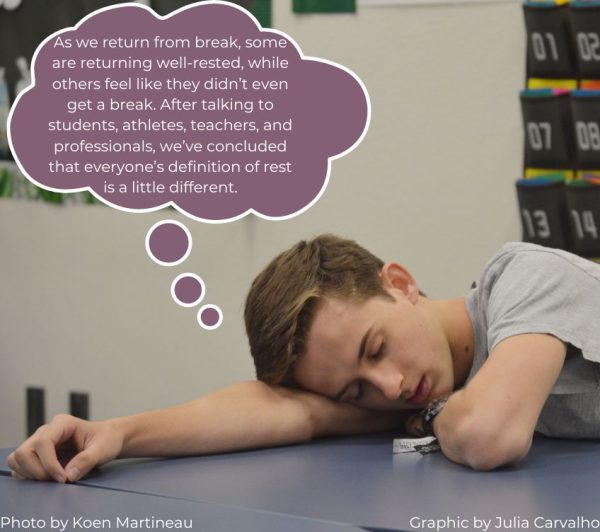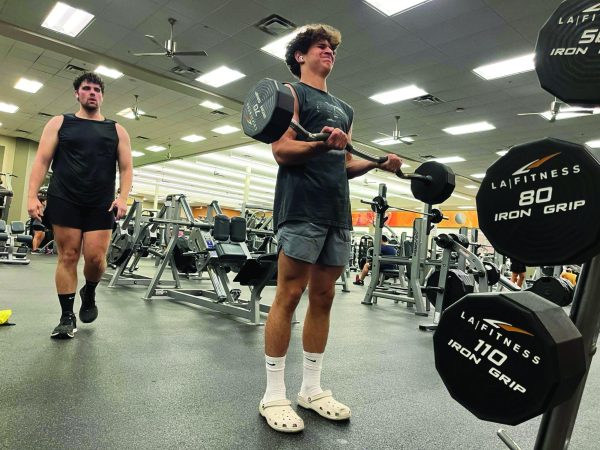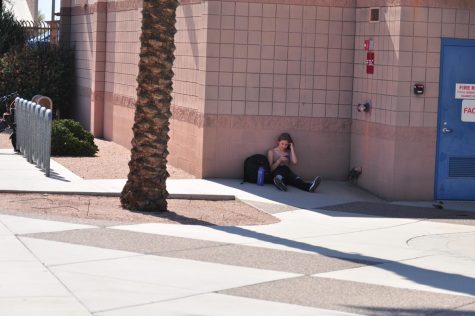Back-to-school stress: how to cope
Senior Joyce Gunaraj works on AP Stat homework, amongst the other obligations of a senior. Many students may feel overwhelmed going back to school, and can use the Wellness Room as a resource.
The end of summer and simultaneous welcome back to school can be an overwhelming, and often stressful time for students. Whether freshmen, who have never experienced the vigor of high school, or returning students, who are entering a new grade with new expectations and pressures, this time can prove to be an instigator for extra stress.
With the more hectic time, it may be possible for students’ mental health to be affected. Transitioning back into a school routine may have a negative effect on those with pre-existing mental health concerns and make the back-to-school period even more difficult.
Those who may be struggling, whether with stress, depression, or any other reason should seek out resources and help. AP Psychology teacher Daleana McPherson recommends, “Talking to someone to help them through what might happen as they return and what are some ways they can handle it that will calm them down.”
For an in-person resource, students can visit the school’s Wellness Room to seek out help and support. The Wellness Room is led by school social worker, Lindsay Taylor. The Wellness Room is open to all, but can specifically help those in need of support.
Many students may be familiar with the Wellness Room but unsure how it can be accessed. Those who are in immediate need of the support provided in the Wellness Room can come during class, after asking their teacher to write them a pass to the counselor’s office. Once the student gets to the counselor’s office, which is located in the front office, to the right after walking in, they will check in with the secretary, Catherine Hendon. Once it is certain that Taylor is available and in the Wellness Room, the student can head over to room C105. The Wellness Room is located in the bottom of the old C building, where ELA and social studies classes usually are.
To schedule an appointment for the Wellness Room, students can scan the QR code that should be in their teachers classroom or around the school. This will allow them to schedule a time in which they can visit the center.
The Wellness Room has also undergone some slight changes in contrast to previous years. For example, the door will be locked and still require the student to knock. There will also be a suggested time limit of about 15 minutes in the room. This limit is subject to change, based on each student’s need. When students enter the Wellness Room, they will now be asked to sign in when first arriving.
The Wellness Room is furnished with a variety of tools and methods to help aid in reducing stress and coping with a mental health need. “We have different coping tools. So we’ve got coping in the corner, coping cards that have different prompts to cope with stress and anxiety, deep breathing exercises, mindfulness prompts, journals,” said Taylor.
In the Wellness Room, students have a variety of options to choose from. “They can talk with me, so if they are needing to get through a situation whether it is problem solving something or dealing with their anxiety, depression. Whatever it is, they can meet with me. Or if they are feeling overwhelmed in their class or are having anxiety and are just needing that few minutes to reset,” Taylor explained. Students can learn a variety of mindfulness and breathing techniques, as well as ways to cope with stress.
With the discussion of mental health and stress, it is also important to differentiate between more common school stress, and a more serious anxiety disorder. All stresses and mental health concerns are valid and legitimate, however, it is important to recognize and acknowledge the difference.
Students with everyday stress may feel worries over an upcoming math test or where they are going to sit at lunch, while someone with more severe anxiety may be afflicted with stress every day, all day. Both types are justified, and can seek support in the Wellness room, whether through the form of mindfulness exercises to calm test nerves, or a quiet place for a more visceral panic attack. McPherson explains, “diagnosed anxiety would be chronic anxiety that someone has had for a longer period of time. School stress is usually not chronic; it happens cause of the moment, and then once you’ve completed what you need to complete you can move on”
In regards to school stress, Taylor recommends, “Don’t overcomplicate it. Focus on getting one assignment done at a time, take on things at a time. I think sometimes when kids look at everything they have to do all at once, it gets overwhelming.” Students can use resources such as the school offered agendas or personally bought planners to stay on-top of school work and talk to teachers to come up with a plan if students begin to miss assignments.
Taylor also wants to remind students that, “Everything is temporary. So if you’re struggling with something now, if you’re feeling overwhelmed, this feeling will pass. You will get through it. I always tell kids when they are feeling stressed, ‘Is this going to matter a week from now, a month from now?’ If it’s not, try and let it go.” With academic, athletic, and social pressures, it may be difficult to move past stressful moments and blunders, but remembering to take it one day at a time can be helpful in working through stressful situations.
The strain of the school year is one that many students may feel and suffer with. It is important for them to know that they are not alone, and Perry has resources and staff that want the best for its students.
For those struggling, important numbers can be, Teen Lifeline– 602-248-TEEN (8336) or 1-800-248-TEEN (8336), National Suicide Prevention Lifeline– 1-800-273-TALK (8255) suicidepreventionlifeline.org, Maricopa crisis line– 602-222-9444. Another helpful resource can be Mrs. Taylor’s website, such as this page which shares some mental health resources, https://www.cusd80.com/Page/105203.

Sophie Barkett is a junior at Perry High. This is her second-year writing in the newspaper, and she is the Reviews/ Opinions editor. Her beats this year...

Holy cow this is Presley's third time writing a description for herself; however, this year she is the managing editor (not a staff reporter)! After working...











